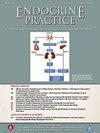高催乳素血症与垂体柄中断综合征成年患者的身高达到或高于目标身高有关。
IF 3.7
3区 医学
Q2 ENDOCRINOLOGY & METABOLISM
引用次数: 0
摘要
目的:除了生长激素(GH)和胰岛素样生长因子1 (IGF-1)外,关于生长促进因子的数据有限。本研究旨在确定垂体柄中断综合征(PSIS)患者生长的相关因素。方法:这项回顾性横断面研究纳入了2021年1月至2024年9月期间的62例成年PSIS患者。比较了人口统计数据、代谢参数和激素状态。采用二元logistic回归评估高胰岛素血症、高泌乳素血症、性激素替代史、甲状腺素替代史与1)身高达到或高于目标身高及2)身高≥-2 SD之间的关系。结果:共纳入62例患者(男53例,女9例),中位年龄30.5岁(范围26.0 ~ 32.4岁)。12名患者达到了目标身高,其余患者没有达到。成年PSIS患者的高泌乳素血症与身高达到或高于目标身高呈正相关(or 6.4, 95% CI: 1.6-24.7, P=0.007),在调整多个混杂因素后,这种关联仍然存在(or 6.89, 95% CI: 1.19-40.81, P=0.032)。此外,高泌乳素血症与身高≥-2 SD呈正相关(OR 10.5, 95% CI: 2.8-38.5, P < 0.001),在调整混杂因素后仍然存在(OR 13.8, 95% CI: 2.5-77.6, P=0.003)。这些关联在男性患者中一致观察到。结论:在中国成年PSIS患者中,高泌乳素血症与身高达到或高于目标身高有关。此外,高泌乳素血症与身高≥-2 SD之间存在显著相关性。本文章由计算机程序翻译,如有差异,请以英文原文为准。
Hyperprolactinemia Is Associated With Height Attainment Within or Above Target Height in Adult Patients With Pituitary Stalk Interruption Syndrome
Objectives
Limited data exist on growth-promoting factors beyond growth hormone and insulin-like growth factor 1. This study aimed to identify factors associated with growth in patients with pituitary stalk interruption syndrome (PSIS).
Methods
This retrospective cross-sectional study included 62 adult patients with PSIS between January 2021 and September 2024. Demographic data, metabolic parameters, and hormone statuses were compared. Binary logistic regression was used to assess the relationships among hyperinsulinemia, hyperprolactinemia, sex hormone replacement history, thyroxine replacement history and 1) height attainment within or above the target height and 2) height ≥ −2 SD.
Results
A total of 62 patients (53 males and 9 females) were included, with a median age of 30.5 years (range: 26.0-32.4). Twelve patients achieved their target height, while the remaining patients did not. Hyperprolactinemia in adult patients with PSIS was positively associated with height attainment within or above the target height (odds ratio [OR] 6.4, 95% CI: 1.6-24.7, P = .007), and this association remained after adjustment for multiple confounders (OR 6.89, 95% CI: 1.19-40.81, P = .032). Additionally, hyperprolactinemia showed a positive association with height ≥ −2 SD (OR 10.5, 95% CI: 2.8-38.5, P < .001), which also remained after adjusting for confounders (OR 13.8, 95% CI: 2.5-77.6, P = .003). These associations were consistently observed in male patients.
Conclusions
Hyperprolactinemia was associated with height attainment within or above the target height and in Chinese adult patients with PSIS. Additionally, a significant correlation was observed between hyperprolactinemia and height ≥ −2 SD.
求助全文
通过发布文献求助,成功后即可免费获取论文全文。
去求助
来源期刊

Endocrine Practice
ENDOCRINOLOGY & METABOLISM-
CiteScore
7.60
自引率
2.40%
发文量
546
审稿时长
41 days
期刊介绍:
Endocrine Practice (ISSN: 1530-891X), a peer-reviewed journal published twelve times a year, is the official journal of the American Association of Clinical Endocrinologists (AACE). The primary mission of Endocrine Practice is to enhance the health care of patients with endocrine diseases through continuing education of practicing endocrinologists.
 求助内容:
求助内容: 应助结果提醒方式:
应助结果提醒方式:


